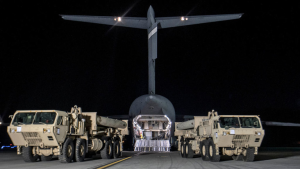MEXICO CITY – Fewer migrants are reaching the U.S. border than in years. The U.S. government’s secret weapon in cutting illegal crossings?
Mexico.
Mexico is holding the line, analysts say, thanks to a carefully negotiated – but unwritten – agreement between neighbors, executed late last year by the Biden-Harris administration. It’s held, they say, because it’s in Mexico’s economic interest to keep the border chaos-free and exports flowing north. And because the political stakes are high for Mexico in the upcoming U.S. presidential election.
Illegal border crossings have been at the center of Republican Donald Trump’s campaign.

Immigration has been seen as one of Democrat Kamala Harris‘ weakest flanks. If Mexico lifted its checkpoints and eased its enforcement, it could sink Harris and buoy Trump, whose campaign has played on American fears and frustrations at the border.
Sign-up for Your Vote: Text with the USA TODAY elections team.
Mexico’s new President Claudia Sheinbaum is aware of her country’s role in stopping migrants, and of the influence Mexico has in the U.S. presidential election, said Arturo Sarukhán, Mexico’s former ambassador to the United States.
“I’m not arguing that they have explicitly decided to intervene or play a role in how Americans vote, but I think they are very aware of the role that Mexico plays in the context of the U.S. election,” he said. Sheinbaum “will try to ensure that migrant flows to the border don’t impact that issue as Americans go to the polls in less than a month.”
Migrant encounters at the U.S. border plunged from nearly 250,000 in December of last year when urgent negotiations began, to below 60,000 last month, the lowest one-month total since the Trump administration, according to data provided to USA TODAY by the U.S. Department of Homeland Security.
At the same time, Mexico’s immigration agency reported a 160% increase in migrant encounters through the first seven months of this year, according to federal data.
Refugees denied border access
The evidence of this policy shift can be seen 1,000 miles south of the U.S. border in the historic center of Mexico’s capital.
Mari Eduvid Sarmiento and Samuel Malave Sarmiento spent weeks trying to make it out of Mexico’s southern states on their journey to the U.S. border with their 12-year-old son, hiding from Mexican immigration agents and federal authorities. They only made it as far as the capital city.
The Venezuelan family’s journey echoed the tales migrants used to tell of sneaking into the United States. “Our passports were worthless,” Eduvid Sarmiento said. “We tried and tried and tried again.”
They took taxis for short distances and at one point walked 13 hours through Mexico’s southern Chiapas state to avoid highways and “la migra,” a word once reserved for U.S. Border Patrol. They sold coffee by the roadside until they reached Veracruz, where they climbed onto the roof of a cargo train, a decision that still gives Eduvid Sarmiento chills.
“It was like staring death in the face,” she said.
A decade, even five years ago, the Mexican government might have issued the Sarmiento family a seven-day travel visa, which many migrants used to reach the U.S. border by bus or plane. They could travel unobstructed, except for occasional bursts of enforcement when either the U.S. became frustrated or Mexico itself wished to reduce the number of migrants in its territory.
Instead, the family only made it as far as Mexico City and were stuck, in late September, living in a tent in plaza crowded with dozens of other tents and lean-tos, where people from Venezuela, Cuba, Haiti, Angola and other countries were all struggling to keep out the rain.
Had they made their journey nine months earlier, they might have faced fewer obstacles in Mexico en route to their dreamed-of destination, New York.
In December 2023, some 10,000 migrants per day were reaching the U.S. border.
Anatomy of a U.S.-Mexico deal on migration
President Joe Biden called his counterpart in Mexico four days before last Christmas.
Months of record migration had provoked humanitarian disasters in U.S. cities from El Paso, Texas, to Denver, Chicago and New York. The swell of migrants was already overwhelming city services and threatened – less than a year from the U.S. presidential election – to erupt into a political disaster for Democrats. A border security bill was being hashed out in Congress but its prospects looked grim.
It wasn’t the first time Biden had discussed the border with Mexico. The two countries had made promises, including a commitment by Mexico in 2022 to spend $1.5 billion on infrastructure at its northern border over two years. Yet illegal crossings had still climbed to a record high.
Six days after the presidential phone call, between the 2023 Christmas and New Year’s holidays, State Department Sec. Antony Blinken, Homeland Security Sec. Alejandro Mayorkas and White House advisor Elizabeth Sherwood-Randall got on a plane to the Mexican capital.
“I’m sure what Blinken, Mayorkas, and Sherwood-Randall brought was a mix of carrots and sticks because the U.S. tends to operate that way,” said Tony Payan, director for the Center for the U.S. and Mexico at Rice University’s Baker Institute.
One “stick” was suspending traffic at five ports of entry between the U.S. and Mexico, including two key commercial rail crossings into Texas.
Mexico sends more than 80% of its exports to the U.S., worth more than $475 billion annually, according to the U.S. Census Bureau. Mexico’s economy takes a direct hit with every slowdown in cross-border commercial traffic.
“The demonstration of shutting the bridges to trade when Mexico is so dependent on trade was significant,” Payan said.
The U.S. delegation came with “specific asks” for Mexico, according to senior State Department officials who spoke to USA TODAY on condition of anonymity to speak freely about the discussions. They included increased migration enforcement on cargo rail and passenger bus lines and for Mexico to “decongest” its northern border with the United States.
Repeating a tactic from the Trump administration, the Biden-Harris administration in December reassigned customs officers to help Border Patrol process migrants. The closed ports “got everybody’s attention,” one of the State department officials said.
In response, Mexico quickly took a series of actions, including imposing visa requirements on migrants of certain nationalities and making it harder to seek asylum in Mexico, a system some migrants had used to travel safely to the U.S. border.
The country ramped up deportation flights to Guatemala and Honduras. Mexico also began a blitz of immigration enforcement along routes north – by bus, plane and train – that hasn’t ended. Once apprehended, Mexican immigration agents transport migrants to the country’s southern region, where they begin their trek northward all over again.
“People are being dumped on the street,” said Gretchen Kuhner, director of the Mexico City-based Institute for Women in Migration.
Mexico has “always had this carousel,” she said, “but it existed to pick up Central Americans and quickly return them. Now they are using the same idea to just tire people out. It opens all these spaces for extortion and violence and kidnapping.”
The migrant ‘carousel’
Eduvid Sarmiento sees no way out of Mexico City without an appointment issued by U.S. Customs and Border Protection on the CBP One app ‒ one of the “lawful pathways” the Biden-Harris administration created to incentivize migrants to present at a port of entry. The family applied in August, with no answer yet.
Earlier in the week another group of Venezuelans, a few dozen people, had tried to board a northbound cargo train. A young man named Yampier Sanchez shot a cellphone video of himself in a Los Angeles ball cap, the landscape rushing by in the background. Mexican immigration agents stopped the train less than two hours outside the city, he said, and put him and others on a bus to Villahermosa in Mexico’s southern Tabasco state.
The same week, a video circulated on social media of a Mexican immigration raid on 10 apartments in a Mexico City borough where migrants were staying. Agents put at least 60 people on a bus, also to Villahermosa, according to a local news report.
Sarmiento and her husband and son had found informal work selling boxer shorts from a stand along a busy boulevard in Mexico City’s historic center. They weaved between a crush of traffic and people selling clothes, pajamas, blankets and aprons. Sex workers waited by the roadside.
The relative safety of the city was a relief compared to the journey through Mexico, she said.
“Every day was a terror,” said Malave Sarmiento, her husband. “So much psychological trauma.”
Their 12-year-old son sat on a plastic stool. It had been months since he’d gone to school.
“We were so afraid for him,” she said.
‘Weaponizing’ migration and putting people at risk
Sarukhán, the former ambassador, said Mexico has “weaponized” migration and turned an issue that requires “shared responsibility” into political leverage.
“I have never seen this type of leverage in the hands of Mexico in the contemporary U.S.-Mexico relationship,” he said.
At the same time, Mexico has sacrificed the values that underpin its own immigration laws, Sarukhán said.
“We’ve jettisoned Mexico’s obligations under international conventions to adequately address the issues migrants face from organized crime and unscrupulous authorities who prey on them,” he said.
Andrew Selee, president of the nonpartisan Migration Policy Institute said that, excepting trade, there are rarely written agreements between the U.S. and Mexico.
“It’s always understandings,” he said. “What Mexico decided to do was something the U.S. had never even thought of: the carousel. That was a Mexican decision. There are policy conversations but, ultimately, each government is making its own decisions.”
Mexico’s immigration agency doesn’t speak publicly about its tactics and a communications spokesman for Sheinbaum’s transition team declined an interview request.
Without an agreement on paper, it’s unclear to what extent the U.S. endorses Mexico’s tactics.
The U.S. isn’t paying for Mexico’s migration enforcement programs, according to State Department officials. The United States provided nearly $87 million in “humanitarian assistance for refugees, asylum seekers and vulnerable migrants in Mexico” in fiscal 2023, according to a State Department spokesman.
Migrant crisis under control ‒ for now
The first two years of the Biden administration produced record highs in migrant encounters, more than 2 million each year in 2021 and 2022. The surge was driven in part by pent-up demand for jobs after the global pandemic shut down travel and depressed economies.
Along the U.S.-Mexico border, the number of migrants encountered by Border Patrol agents dropped in half immediately after the cabinet secretaries rushed to Mexico City.
Migrant encounters plummeted again after the White House issued an executive order in June restricting asylum at the U.S. border. The number dropped below 60,000 in July, August and September.
On Sept. 30, the Biden-Harris administration further cemented its executive order with a final rule restricting asylum access at the U.S. border.
Whether Mexico, and Sheinbaum’s newly inaugurated government will keep up the enforcement regime is an open question. Last week, she named a new head of the country’s National Migration Institute, whose current leader is facing criminal charges in the deaths of 40 migrants in a migration detention center fire in 2023.
State Department officials told USA TODAY there is an informal commitment that Sheinbaum will continue Mexico’s enforcement regime.
“They are aware, for different political reasons,” Sarukhán, the former ambassador, said, “that what they do on the ground in Mexico does have a potential impact on the outcome of the election in November.”
Reprinted from USA Today

